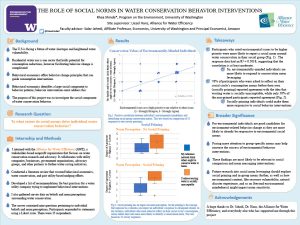THE ROLE OF SOCIAL NORMS IN WATER CONSERVATION BEHAVIOR INTERVENTIONS
The U.S is facing a future of water shortages and heightened water vulnerability. Residential water use is one sector that offers potential for consumption improvements; behavior change interventions offer a new way forward in these efforts. Since behavior change has a large social component, the aim of this research was to understand how social norms impact the ways in which individuals think about water conservation. The internship portion of this project was completed with the Alliance for Water Efficiency and consisted of creating a literature review on applications of behavioral economic principles to water conservation efforts and constructing a list of recommendations on which principles were most applicable to the task. This research was supplemented by a survey designed to eke out Greater Seattle Area residents’ perceptions and opinions about water use norms and behaviors. Water use social norms were found to be most prevalent to people already environmentally inclined. Additionally, people who report taking conservation actions around their home are also more likely to perceive conservation norms. Lastly, socially priming individuals made them more likely to perceive conservation norms. These results are significant in guiding how to choose the type of behavior interventions that will be most impactful in a given population. It also highlights the importance of paying attention to in-group norms when designing behavior interventions. For example, social comparisons are more likely to lead to decreases in water consumption in environmentally friendly areas, while more specific in-group norms may need to be leveraged for less pro-environment populations.
